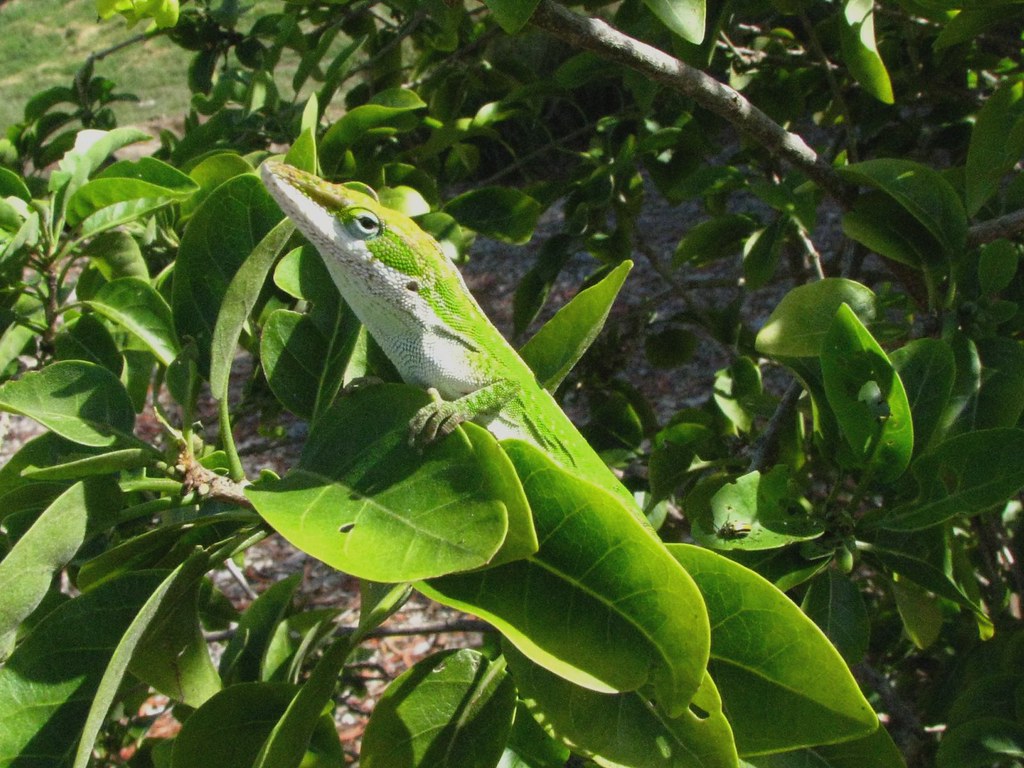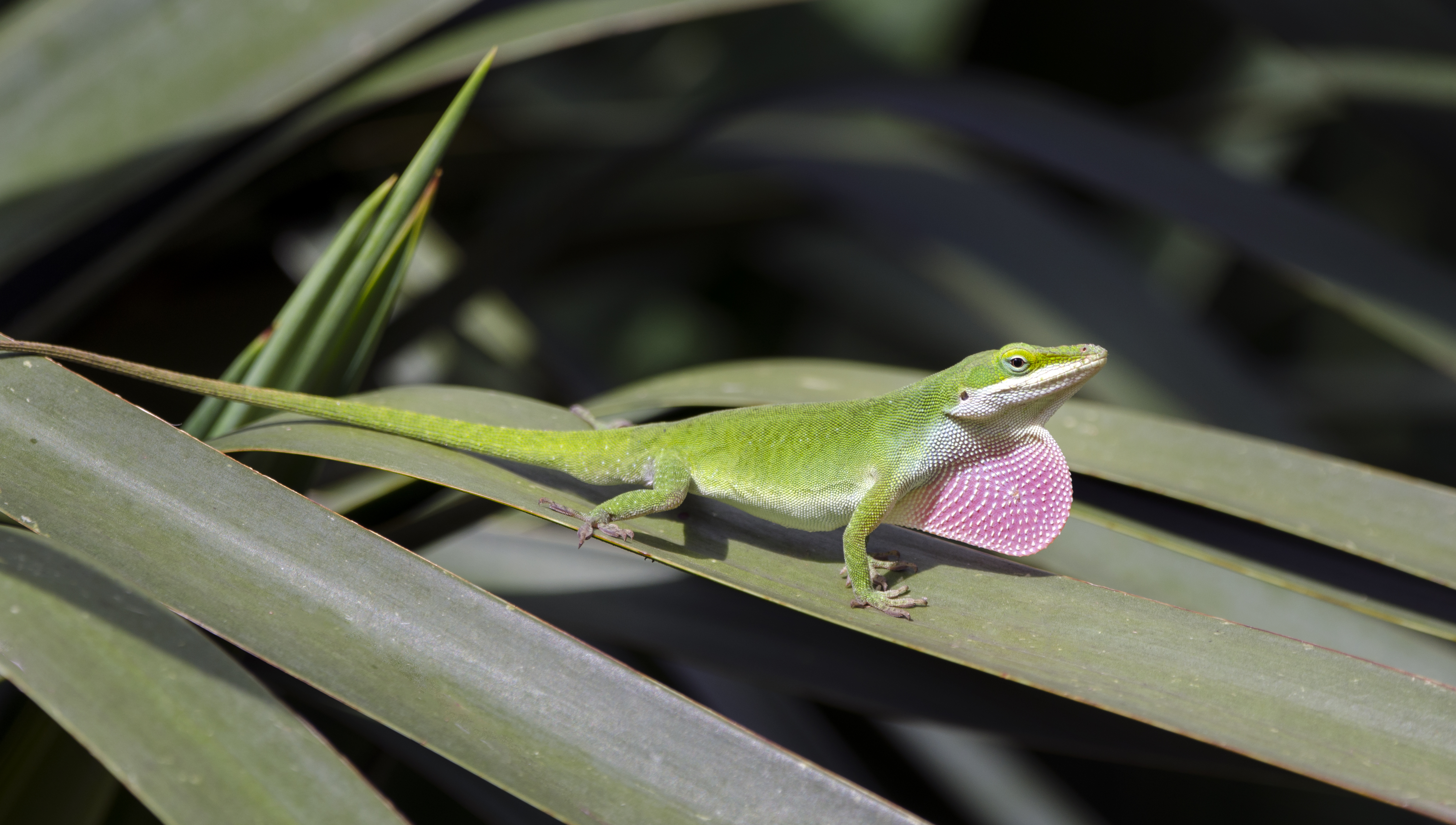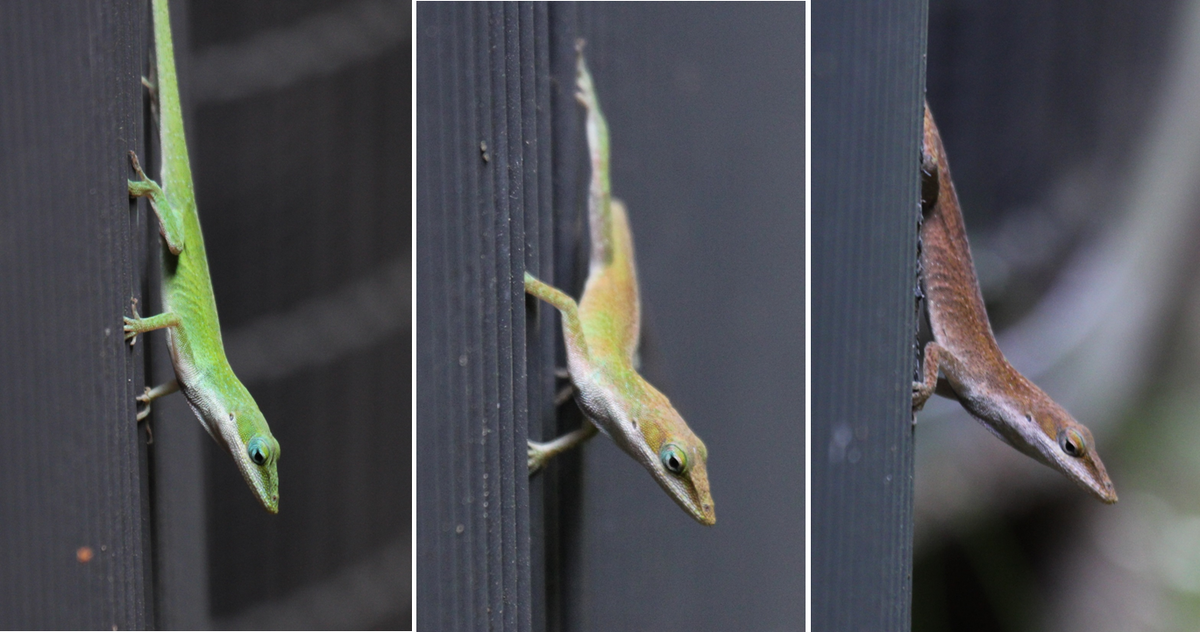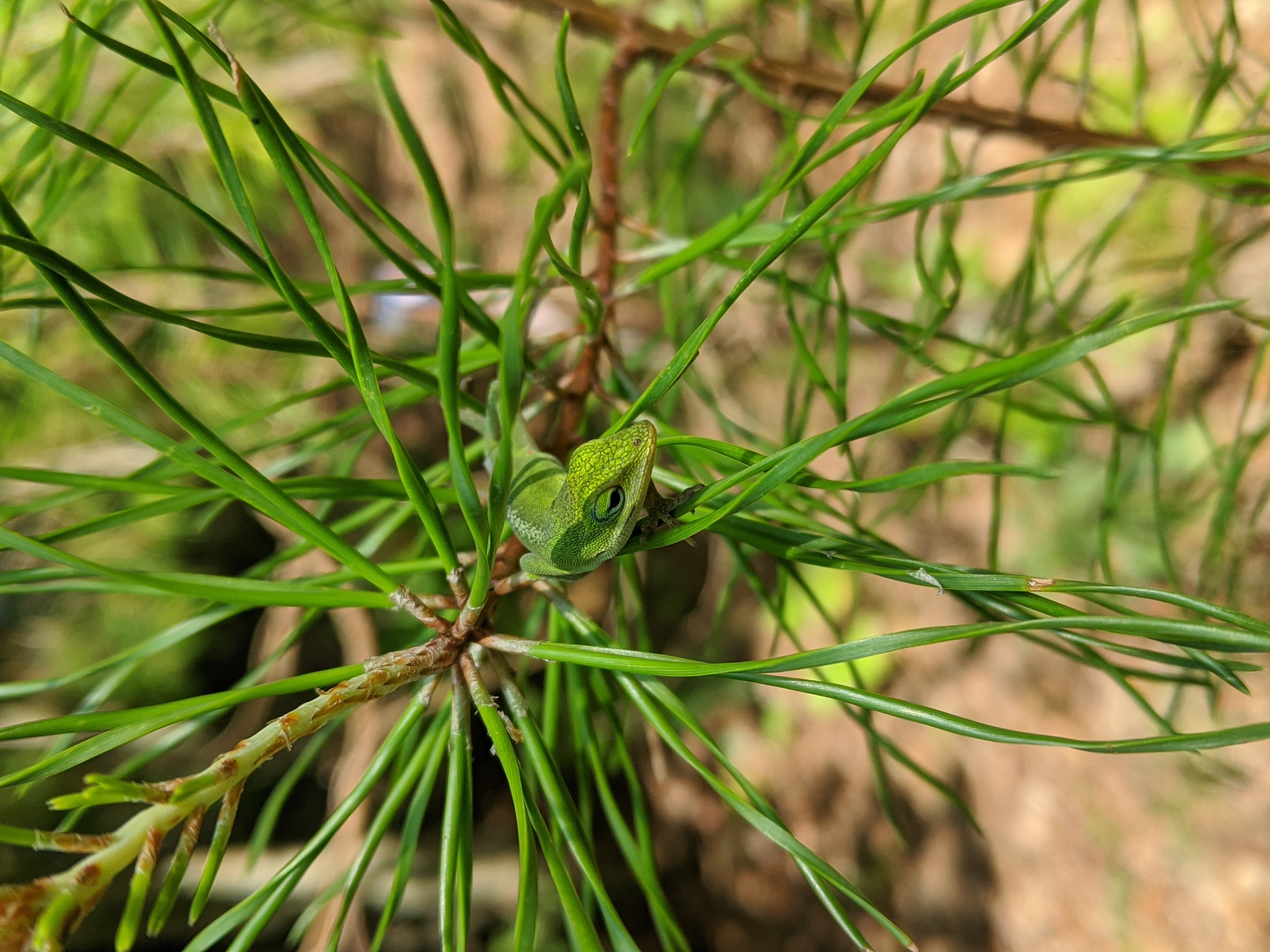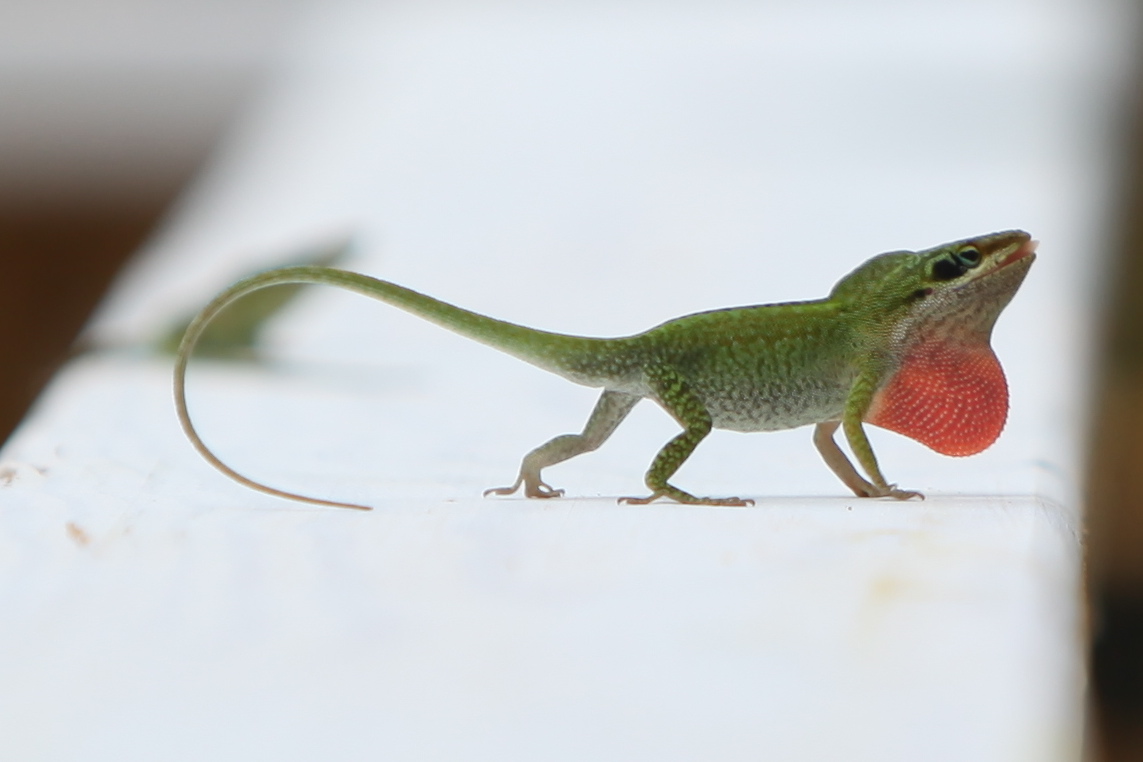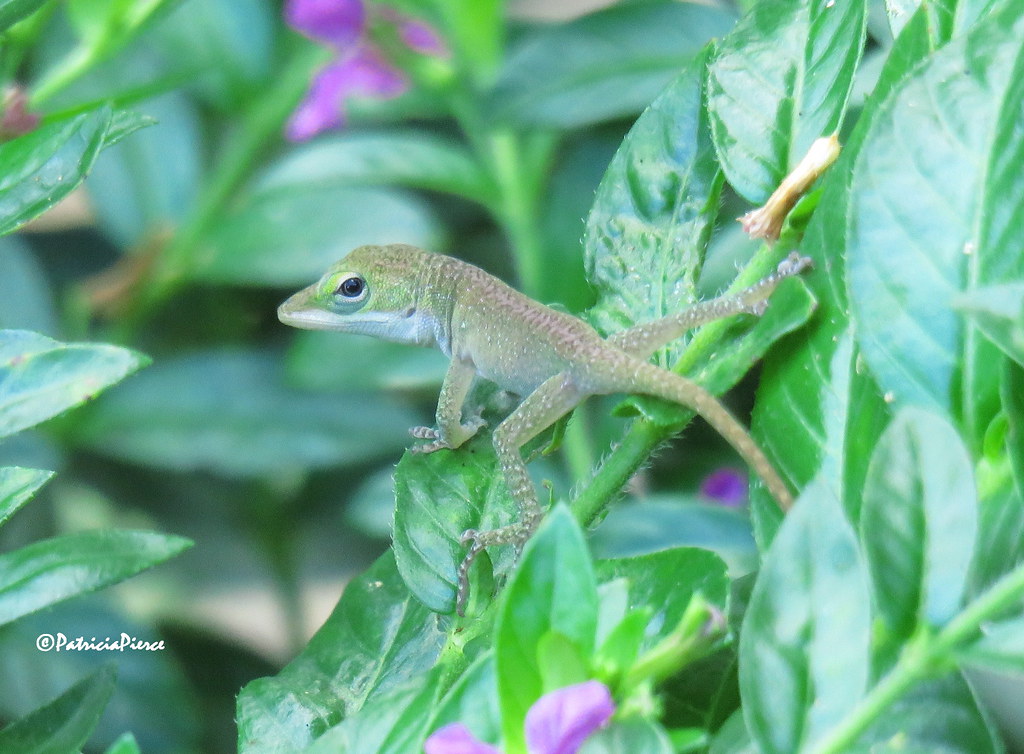Wonders of Wildlife: Green Anole
Green Anole
Other Common Names: chameleon
Scientific Name: Anolis carolinensis
Found in Alabama: Mostly common statewide, relatively scarce in extreme northern portion
Diet: Carnivore (eats animals) |
Green Anole in Habitat
Flickr - David Eickhoff
Click image to enlarge it |
Learn more about...
| CLASSIFICATION |
|
What type of animal am I?
- I am a vertebrate (an animal with a spine or backbone).
- I am cold-blooded, so I cannot control my body temperature.
- I have scales on the outside of my body.
- I breathe with lungs just like you.
- I have 4 legs.
|
Scientists use basic traits to group animals into different taxonomic classes.
For a taxonomic classification chart comparing key traits of common backyard wildlife,
CLICK HERE! |
|
| The Green Anole is a REPTILE! |
| IDENTIFICATION TIPS |
| |
|
|
Size: |
- Adults reach 5-8 inches in length.
- Males are slightly larger than females.
|
Key Characteristics: |
- Color ranges from bright green to brown.
- Have a long slender body
- Pointed snout
- males have a bright pink dewlap (flap of skin) that hangs beneath the neck.
|
Male Green Anole
Dreamstime
Click on image to enlarge it
|
Juveniles (young): |
- Similar in appearance to adults but smaller in size.
|
| ADAPTATIONS |
| |
| PHYSICAL ADAPTATIONS |
| |
| Green Anoles can change colors: |
- The green anole is often called 'chameleon' because of their ability to change colors from bright green to brown.
- They have specialized structures just below the skin which allow them to changed colors.
- They change color based on internal and external factors like body temperature and excitement.
- They have the ability to appear brown if they are cold or stressed.
|
Green Anole Changing Colors
Wikimedia - Huhnra
Click on image to enlarge it
|
| |
| Green Anoles avoid predators: |
- Green anoles have a variety of adaptations that help them avoid being eaten by predators (animals that eat them).
- Their coloration provides camouflage,(the ability to blend in with their surroundings).
- They also have sticky-like structures on their footpads which allow them to walk up and down along vertical surfaces.
- They may also leap and glide down from higher points in trees, using a membrane of skin located near the front and hind legs.
|
Green Anole
Monty Morris
Click on image to enlarge it
|
| |
| |
| BEHAVIORAL ADAPTATIONS |
| |
| Green Anoles are diurnal: |
- They are active during the day (diurnal).
|
| |
| Green Anole males show dominance: |
- The green anole is a territorial species and only hunts within its own area.
- Males show displays in order to protect their territories.
- Generally, males that are larger in size will be more dominant and have larger territories.
- If a male feels the need to show dominance to protect their territory, they will bob their heads up and down, do a push-up like movement, and flare their pink dewlap.
- Females also chose a male based on the size of their territory and dominance.
|
Male Green Anole Showing Dominance
Gregory Glasscock
Click on image to enlarge it |
| |
| LIFE CYCLE |
| |
|
|
| Life Cycle Stages of the Green Anole |
| |
|
|
Nest: |
- Eggs are deposited in moist soil, moist leaf litter, or in hollow logs.
|
| |
|
|
Eggs: |
- Females lay one single hard-shelled at a time every two weeks.
- They can lay up to 10 eggs total for the breeding season.
|
Baby Green Anole
Flickr - Patricia Pierce
Click on image to enlarge it |
| |
|
Young: |
- The female does not stick around to care for the eggs.
- Young are independent and can hunt for themselves when they hatch from the eggs.
|
| |
|
|
| Life Span: |
- Average of 5-5.5 years but can potentially live up to 8 years.
|
| NATURAL Habitat Needs |
ADULTS |
YOUNG |
| Food |
- Green anoles are carnivores (eat animals).
- Feed on insects, grubs, beetles, flies, crickets, moths, butterflies, and spiders.
- In rare circumstances, they will eat mollusks, grain, and seeds.
|
| Water |
- Require a moist or humid environment.
- Commonly found in swamps and forests.
- Will drink from water collected from dew or after rain showers.
|
| Shelter |
- Require green plants and are primarily arboreal (living in trees).
- Perch at different heights within the trees.
- Will take shelter among wildflowers, low bushes, and shrubs that provide cover.
|
| Places to Raise Young |
- Females deposit their eggs in moist soil.
- Young are independent upon hatching.
|
|
BACKYARD
Habitat Needs |
ADULTS |
YOUNG |
| Food |
- Provide vegetation to support insect life such as un-mowed grasses, logs, trees, and bushes.
- Do not spray pesticides that might harm insect populations.
|
| Water |
- Provide plenty of plants which can collect rainwater and dew.
|
| Shelter |
- Plant flowers, tall grasses, and low bushes that provide plenty of cover.
- Plant trees that will provide a place for them to perch.
- They will also perch on manmade structures like walls, fences, and rooftops.
|
| Places to Raise Young |
- Provide a space with moist soil in which the females can deposit their eggs.
- Young are independent upon hatching.
|
|
| ECOLOGICAL ROLE |
| |
|
| Animals play an important ecological role in the health of habitats and ecosystems. |
| |
|
|
Food Source:
|
- Green anoles are eaten by snakes, kestrels, thrashers, and some larger reptiles.
|
| |
|
Insect Control: |
- Green anoles eat a large amount of invertebrates (animals without a spine or backbone), keeping these populations under control.
|
INFORMATION SOURCES FOR THIS SPECIES
|
|
|
|
| |
|
|
|
|
|
|
| |
|
|
|
John B. Jensen. Amphibians and Reptiles of Georgia. University of Georgia Press, 2008.
|
|
|
| |
|
|
.




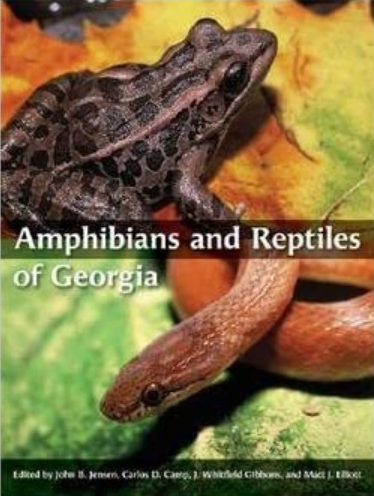
 Wildlife Tag
Wildlife Tag
